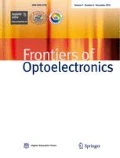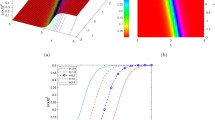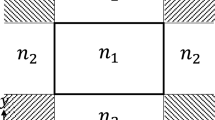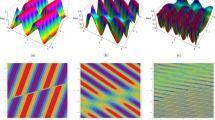Abstract
Given a constitutive relation of the bianisotropic medium, it is not trivial to study how light interacts with the photonic bianisotropic structure due to the limited available means of studying electromagnetic properties in bianisotropic media. In this paper, we study the electromagnetic properties of photonic bianisotropic structures using the finite element method. We prove that the vector wave equation with the presence of bianisotropic is self-adjoint under scalar inner product. we propose a balanced formulation of weak form in the practical implementation, which outperforms the standard formulation in finite element modeling. Furthermore, we benchmark our numerical results obtained from finite element simulation in three different scenarios. These are bianisotropy-dependent reflection and transmission of plane waves incident onto a bianisotropic slab, band structure of bianisotropic photonic crystals with valley-dependent phenomena, and the modal properties of bianisotropic ring resonators. The first two simulated results obtained from our modified weak form yield excellent agreements either with theoretical predictions or available data from the literature, and the modal properties in the last example, i.e., bianisotropic ring resonators as a polarization-dependent optical insulator, are also consistent with the theoretical analyses.

Similar content being viewed by others
References
Gansel J K, Thiel M, Rill M S, Decker M, Bade K, Saile V, von Freymann G, Linden S, Wegener M. Gold helix photonic metamaterial as broadband circular polarizer. Science, 2009, 325(5947): 1513–1515
Kriegler C E, Rill M S, Linden S, Wegener M M. Bianisotropic photonic metamaterials. IEEE Journal of Selected Topics in Quantum Electronics, 2010, 16(2): 367–375
Soukoulis C M, Wegener M. Past achievements and future challenges in the development of three-dimensional photonic metamaterials. Nature Photonics, 2011, 5(9): 523–530
Guo Q, Gao W, Chen J, Liu Y, Zhang S. Line degeneracy and strong spin-orbit coupling of light with bulk bianisotropic metamaterials. Physical Review Letters, 2015, 115(6): 067402
Slobozhanyuk A P, Khanikaev A B, Filonov D S, Smirnova D A, Miroshnichenko A E, Kivshar Y S. Experimental demonstration of topological effects in bianisotropic metamaterials. Scientific Reports, 2016, 6(1): 22270
Moritake Y, Tanaka T. Bi-anisotropic Fano resonance in three-dimensional metamaterials. Scientific Reports, 2018, 8(1): 9012
Yu Y Z, Kuo C Y, Chern R L, Chan C T. Photonic topological semimetals in bianisotropic metamaterials. Scientific Reports, 2019, 9(1): 18312
Pfeiffer C, Grbic A. Bianisotropic metasurfaces for optimal polarization control: analysis and synthesis. Physical Review Applied, 2014, 2(4): 044011
Pfeiffer C, Zhang C, Ray V, Guo L J, Grbic A. Polarization rotation with ultra-thin bianisotropic metasurfaces. Optica, 2016, 3(4): 427–432
Pfeiffer C, Zhang C, Ray V, Guo L J, Grbic A. High performance bianisotropic metasurfaces: asymmetric transmission of light. Physical Review Letters, 2014, 113(2): 023902
Odit M, Kapitanova P, Belov P, Alaee R, Rockstuhl C, Kivshar Y S. Experimental realisation of all-dielectric bianisotropic metasurfaces. Applied Physics Letters, 2016, 108(22): 221903
Epstein A, Eleftheriades G V. Arbitrary power-conserving field transformations with passive lossless omega-type bianisotropic metasurfaces. IEEE Transactions on Antennas and Propagation, 2016, 64(9): 3880–3895
Asadchy V S, Díaz-Rubio A, Tretyakov S A. Bianisotropic metasurfaces: physics and applications. Nanophotonics, 2018, 7(6): 1069–1094
Li J, Shen C, Díaz-Rubio A, Tretyakov S A, Cummer S A. Systematic design and experimental demonstration of bianisotropic metasurfaces for scattering-free manipulation of acoustic wave-fronts. Nature Communications, 2018, 9(1): 1342
Li J, Díaz-Rubio A, Shen C, Jia Z, Tretyakov S A, Cummer S. Highly efficient generation of angular momentum with cylindrical bianisotropic metasurfaces. Physical Review Applied, 2019, 11(2): 024016
Chen X, Wu B I, Kong J A, Grzegorczyk T M. Retrieval of the effective constitutive parameters of bianisotropic metamaterials. Physical Review E, 2005, 71(4): 046610
Li Z, Aydin K, Ozbay E. Determination of the effective constitutive parameters of bianisotropic metamaterials from reflection and transmission coefficients. Physical Review E, 2009, 79(2): 026610
Ouchetto O, Qiu C W, Zouhdi S, Li L W, Razek A. Homogenization of 3-D periodic bianisotropic metamaterials. IEEE Transactions on Microwave Theory and Techniques, 2006, 54(11): 3893–3898
Hasar U C, Muratoglu A, Bute M, Barroso J J, Ertugrul M. Effective constitutive parameters retrieval method for bianisotropic metamaterials using waveguide measurements. IEEE Transactions on Microwave Theory and Techniques, 2017, 65(5): 1488–1497
Zhao J, Jing X, Wang W, Tian Y, Zhu D, Shi G. Steady method to retrieve effective electromagnetic parameters of bianisotropic metamaterials at one incident direction in the terahertz region. Optics & Laser Technology, 2017, 95: 56–62
Shaltout A, Shalaev V, Kildishev A. Homogenization of bianisotropic metasurfaces. Optics Express, 2013, 21(19): 21941–21950
Albooyeh M, Tretyakov S, Simovski C. Electromagnetic characterization of bianisotropic metasurfaces on refractive substrates: General theoretical framework. Annalen der Physik, 2016, 528(9–10): 721–737
Lindell I V, Sihvola A H, Viitanen A J, Tretyakov S A. Electromagnetic Waves in Chiral and Bi-Isotropic Media. Boston: Artech House on Demand, 1994
Serdiukov A, Semchenk I, Tertyakov S, Sihvola A. Electromagnetics of Bi-Anisotropic Materials-Theory and Application. Singapore: Gordon and Breach, 2001
Sersic I, Tuambilangana C, Kampfrath T, Koenderink A F. Magnetoelectric point scattering theory for metamaterial scatterers. Physical Review B, 2011, 83(24): 245102
Peng L, Zheng X, Wang K, Sang S, Chen Y, Wang Y G. Layer-by-layer design of bianisotropic metamaterial and its homogenization. Progress In Electromagnetics Research, 2017, 159: 39–47
Xu J, Wu B, Chen Y. Elimination of polarization degeneracy in circularly symmetric bianisotropic waveguides: a decoupled case. Optics Express, 2015, 23(9): 11566–11575
Multiphysics COMSOL. 5.2: a finite element analysis, solver and simulation software
Dong J W, Chen X D, Zhu H, Wang Y, Zhang X. Valley photonic crystals for control of spin and topology. Nature Materials, 2017, 16(3): 298–302
Acknowledgements
The authors acknowledge the financial support from the National Key Research and Development Program of China (No. 2019YFB2203100) and the National Natural Science Foundation of China (Grant No. 11874026).
Author information
Authors and Affiliations
Corresponding author
Additional information
Zhongfei Xiong received his B.S. degree in Optoelectronic Information Engineering from Huazhong University of Science and Technology, China. He is currently pursuing his Ph.D. degree in Optical Engineering at School of Optical and Electronic Information, Huazhong University of Science and Technology. His major research interests include topological photonics, symmetry in optics and thermodynamics optics.
Weijin Chen received his Bachelor degree from Harbin Institute of Technology, China, in 2015, and Ph.D. degree from Huazhong University of Science and Technology, China, in 2020. He is currently a Research Fellow in Department of Electrical and Computer Engineering (ECE), National University of Singapore, Singapore. Chen’s research focuses on the Mie scattering, scattering invariance, and coupledmode theory.
Zhuoran Wang is a research assistant in School of Optical and Electrical Information, Huazhong University of Science and Technology, China. He received the Master degree in Engineering from University of Science and Technology, China, in 2020. His research area involved computational electromagnetics, topological photonics, and Non-Hermition photonics. He proposed a new boundary condition, Non-Hermition port, so as to numerically calculate the S parameters of a Non-Hermition system. Besides, he used finite element method to calculate the eigenmodes of bianisotropic waveguide. Currently, he is focusing on developing an optical simulation software in order to replace the COMSOL, FDTD.
Jing Xu received her Ph.D. degree in Optical Engineering from Huazhong University of Science and Technology (HUST), China, in 2008. During 2009–2013, she has been a postdoctoral fellow at Technical University of Denmark (DTU), Denmark. From November 2013, Dr. Xu joined School of Optical and Electronic Information, HUST, as an associate professor. Since 2020, Dr. Xu become a full professor at HUST.
Yuntian Chen received his Ph.D. degree from Technical University of Denmark (DTU), Denmark, in 2010. During 2010–2013, he has been a postdoctoral fellow at Technical University of Denmark. From September 2013, Dr. Yuntian Chen joined School of Optical and Electronic Information in Huazhong University of Science and Technology, China, as an associate professor.
Rights and permissions
About this article
Cite this article
Xiong, Z., Chen, W., Wang, Z. et al. Finite element modeling of electromagnetic properties in photonic bianisotropic structures. Front. Optoelectron. 14, 148–153 (2021). https://doi.org/10.1007/s12200-021-1213-5
Received:
Accepted:
Published:
Issue Date:
DOI: https://doi.org/10.1007/s12200-021-1213-5




